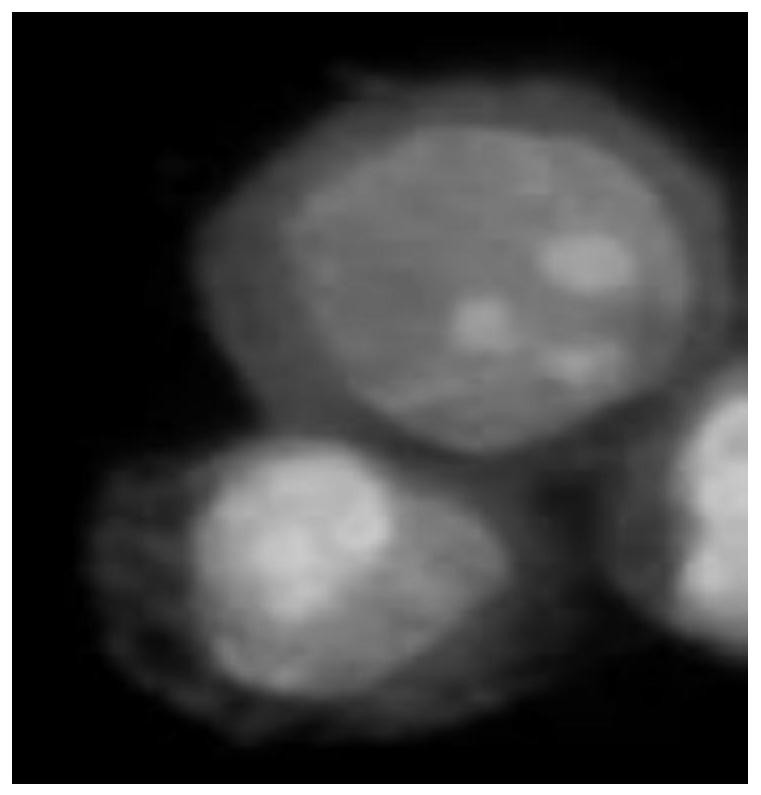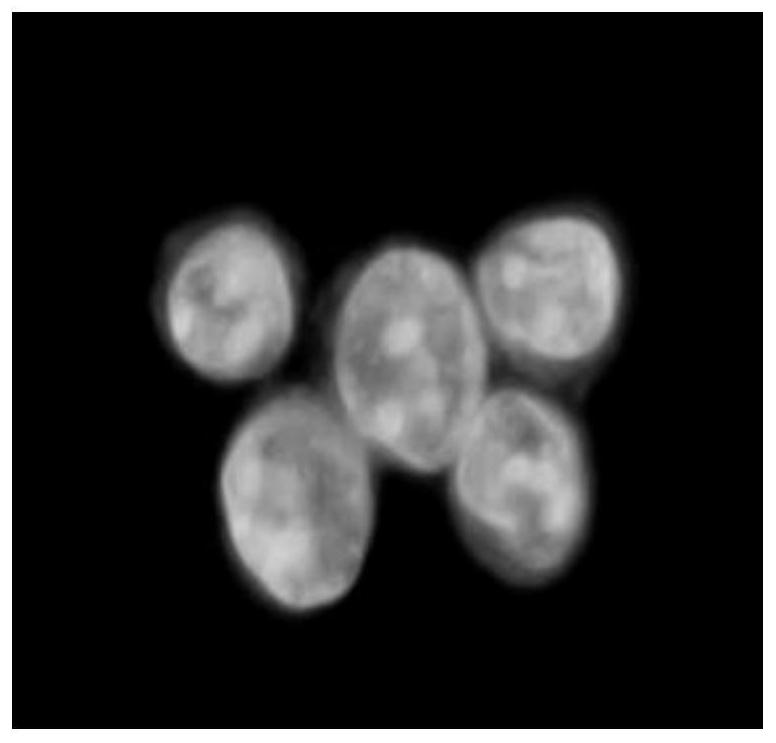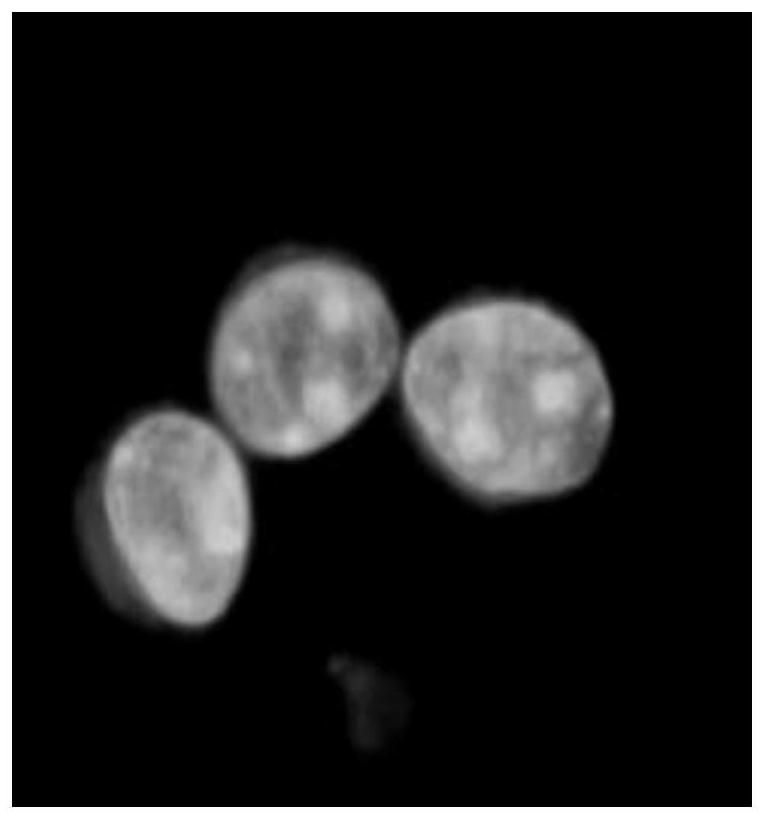Human exfoliated cell immunofluorescent staining kit and method
A technology of immunofluorescence staining and exfoliated cells, which is applied in the field of fluorescent staining reagents, can solve the problems of inability to distinguish nucleoli and nucleoplasm, the troubles of malignant tumor cell morphology detection, and the inability to clearly mark nucleoli.
- Summary
- Abstract
- Description
- Claims
- Application Information
AI Technical Summary
Problems solved by technology
Method used
Image
Examples
Embodiment 1
[0072] Example 1 Fluorescent staining of CTC cells
[0073] (1) The reagents of the kit include:
[0074] Cell fixative: methanol, acetone, paraformaldehyde.
[0075] Cell blocking solution includes: pH 7.2-7.4 PBS (containing 1% BSA or calf serum).
[0076] The rinse solution includes: pH 7.2-7.4 PBS (with Tween-20).
[0077] Diluents include: pH 7.2-7.4 PBS (containing 1% BSA or calf serum).
[0078] Cell membrane and nuclear membrane permeabilizers include: 0.2-0.5% Triton X-100.
[0079] Nucleolar marker fluorescent dye Syto RNA select green.
[0080] Monoclonal antibody red fluorescent marker for CK, EpCAM, and vimentin.
[0081] Other reagents: phosphate buffered saline (PBS), bovine serum albumin (BSA), donkey plasma (clear), Tween-20, Tris-HCl, etc.
[0082] (2) Fluorescence staining method:
[0083] ① Prepare CTC cell detection sheet.
[0084] ②Fix the cells with methanol or 4% paraformaldehyde for 10-20 minutes.
[0085] ③ Wash with rinsing solution (pH7.2-7...
Embodiment 2
[0091] Example 2 Fluorescent staining of exfoliated cells in pleural and ascites
[0092] (1) Kit reagents:
[0093] Cell fixative: methanol, acetone, paraformaldehyde.
[0094] Cell blocking solution includes: pH 7.2-7.4 PBS (containing 1% BSA or calf serum).
[0095] The rinse solution includes: pH 7.2-7.4 PBS (with Tween-20).
[0096] Diluents include: pH 7.2-7.4 PBS (containing 1% BSA or calf serum).
[0097] Cell membrane and nuclear membrane permeabilizers include: 0.2-0.5% Triton X-100.
[0098] Nucleolar marker fluorescent dye Syto RNA select green.
[0099] EpCAM, CK monoclonal antibody red fluorescent marker.
[0100] Other reagents: phosphate buffered saline (PBS), bovine serum albumin (BSA), donkey plasma (clear), Tween-20, Tris-HCl, etc.
[0101] (2) Fluorescence staining method:
[0102] ①Preparation of pleural and ascites exfoliated cell detection sheet.
[0103] ②Fix the cells with methanol or 4% paraformaldehyde for 10-20 minutes.
[0104] ③ Wash with...
Embodiment 3
[0110] Example 3 Fluorescent staining of blood disease cells
[0111] (1) Kit reagents
[0112] Cell fixative: methanol, acetone, paraformaldehyde.
[0113] Cell blocking solution includes: pH 7.2-7.4 PBS (containing 1% BSA or calf serum).
[0114] The rinse solution includes: pH 7.2-7.4 PBS (with Tween-20).
[0115] Diluents include: pH 7.2-7.4 PBS (containing 1% BSA or calf serum).
[0116] Cell membrane and nuclear membrane permeabilizers include: 0.2-0.5% Triton X-100.
[0117] Nucleolar marker fluorescent dye Syto RNA select green.
[0118] CD45 monoclonal antibody red fluorescent marker.
[0119] Other reagents: phosphate buffered saline (PBS), bovine serum albumin (BSA), donkey plasma (clear), Tween-20, Tris-HCl, etc.
[0120] (2) Fluorescent staining method
[0121] ①Prepare blood disease cell test pieces.
[0122] ②Fix the cells with methanol or 4% paraformaldehyde for 10-20 minutes.
[0123] ③ Wash with rinsing solution (pH7.2-7.4PBS (containing Tween-20)) f...
PUM
 Login to View More
Login to View More Abstract
Description
Claims
Application Information
 Login to View More
Login to View More - R&D
- Intellectual Property
- Life Sciences
- Materials
- Tech Scout
- Unparalleled Data Quality
- Higher Quality Content
- 60% Fewer Hallucinations
Browse by: Latest US Patents, China's latest patents, Technical Efficacy Thesaurus, Application Domain, Technology Topic, Popular Technical Reports.
© 2025 PatSnap. All rights reserved.Legal|Privacy policy|Modern Slavery Act Transparency Statement|Sitemap|About US| Contact US: help@patsnap.com



